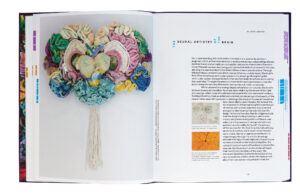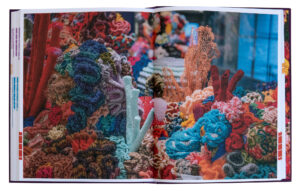SDA Book Club: “Radical Fiber” reviewed by Vivien Zepf
May 3, 2024
Radical Fiber: Threads Connecting Art and Science edited by Rebecca McNamara

Imagine you’re holding a knitted mass of colorful yarns. As you turn it over in your hands, the genius of this anatomical model called Knitted Brain #2 begins to reveal itself. Tightly coiled fibers represent sections of the brain with greater cellular density, while more loosely knotted sections depict regions with less neural activity. Colored fibers travel through the mass, expressing how different regions of the brain are connected and might work together. Threads of different colors appearing in the same area help to convey the multimodal nature of the brain.

Karen Norberg, Knitted Brain #2, 2022. Knitted cotton yarn, nylon zippers, metal zipper pulls, metal snaps, magnets, left: 3.5 x 6 x 8.75 inches, right: 5 x 6.5 x 4 inches. Collection of the artist. Image courtesy The Frances Young Tang Teaching Museum and Art Gallery at Skidmore College.
Knitted Brain #2, created by psychiatrist Dr. Karen Norberg, was just one of the many ingenious works presented in the 2022 Frances Young Tang Teaching Museum and Art Gallery at Skidmore College exhibition Radical Fiber: Threads Connecting Art and Science. Radical Fiber. The exhibition catalog offers readers an opportunity to explore the objects which were on display and, with its additional essays, panel discussion transcripts, photographs and illustrations, to delve more deeply into the material.
Radical Fiber postulates that art and science benefit by cross-pollinated ideation. This is expressed with objects in which fiber, in various forms and applications, is used as a means to explore mathematical, philosophical, and scientific concepts. Mathematician and artist Daina Taimina, for example, crocheted the first three-dimensional hyperbolic model to further her own understanding of the exponential nature of space in plane geometry. Her work later influenced Christine and Margaret Wertheim of the Institute for Figuring to initiate Crochet Coral Reef, a global public artwork initiative to stimulate conversations about coral reef death, applied mathematics and perceptions about “women’s work”. Members of the public submitted imagined pieces of coral crocheted using one of six patterns extrapolated from Taimina’s original hyperbolic model. These, then, were gathered into a reef-like installation. For its exhibition, the Tang Museum sponsored the Saratoga Springs Satellite Reef whose participants, like others, learned hyperbolic geometry while crocheting for the benefit of art and the environment. It’s easy to trace how fiber impacted multiple levels of pedagogy along this stream of experiences. Throughout Radical Fiber, readers are introduced to a diverse collection of projects and topics creatively combining science and fiber, including how scientists are using embroidery to teach computer coding and quilt-making to explore pi; how researchers are exploring the tactile information conveyed in ancient fibers to understand culture and studying emotional processing using woven tapestry portraits. Conversations about fast fashion, synthetic fibers and the continuing impact of the global textile industry are also shared, which include thought-provoking, environmentally-sustainable ideas for progress.

Christine and Margaret Wertheim and the Institute for Figuring, Crochet Coral Reef, conceptualized 2005, made 2021–22. Crocheted yarn, plastic, wire, dimensions variable. Image courtesy The Frances Young Tang Teaching Museum and Art Gallery at Skidmore College.
[If space is limited, OK to use shorter version: Image courtesy Tang Teaching Museum, Skidmore College]

Installation view of Radical Fiber, featuring: Left: Soft Monitor (Victoria Manganiello and Julian Goldman), c o m p u t e r 1.0, 2018/2021. Hollow polymer tubing, natural fiber thread, liquid, operating system, dimensions vary. Collection of the artists. Right: Unidentified maker, Model of a Jacquard loom, 1825. Wood, metal, paper punch cards, 15 x 23 x 7 inches. Courtesy of the Computer History Museum, B117.80. Image courtesy The Frances Young Tang Teaching Museum and Art Gallery at Skidmore College.
“It all began with string,” noted Clare Hunter in Threads of Life. Radical Fiber reveals how the humble, yet profound, invention of twisted and drawn fiber continues to inform, inspire and advance a multitude of diverse disciplines. This has whetted my appetite for more. I’ve already written to my scientist sister-in-law.
–Viven Zepf
- Publisher: The Frances Young Tang Teaching Museum and Art Gallery at Skidmore College and Delmonico Books/D.A.P. (buy it here)
- Date: October 2023
- ISBN: 978-1636810409
If you’ve read this book, leave a comment and let us know what you think!
Do you have a recommendation for a recent fiber-related book you think should be included in SDA’s Book Club? Email SDA’s Managing Editor, Lauren Sinner, to let her know!
